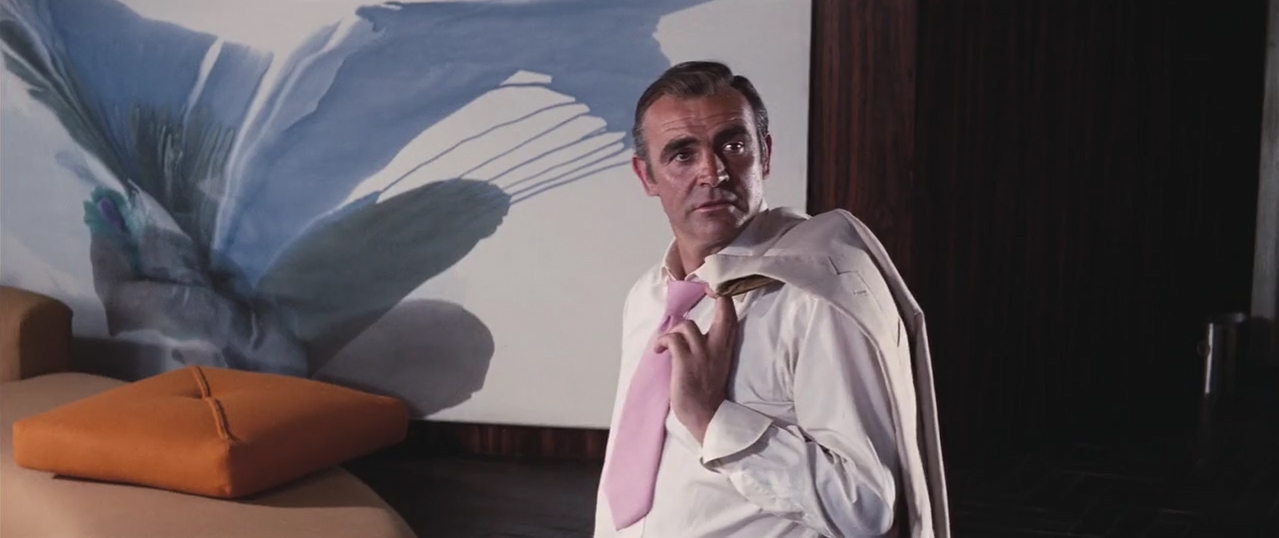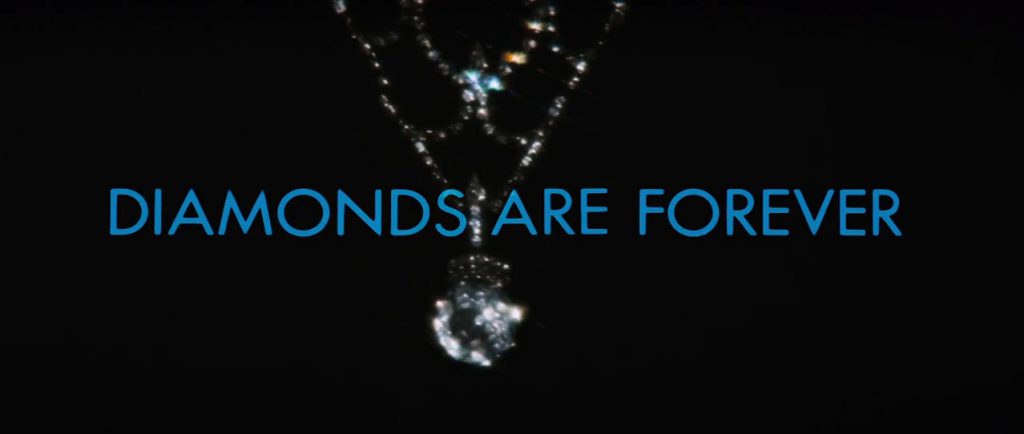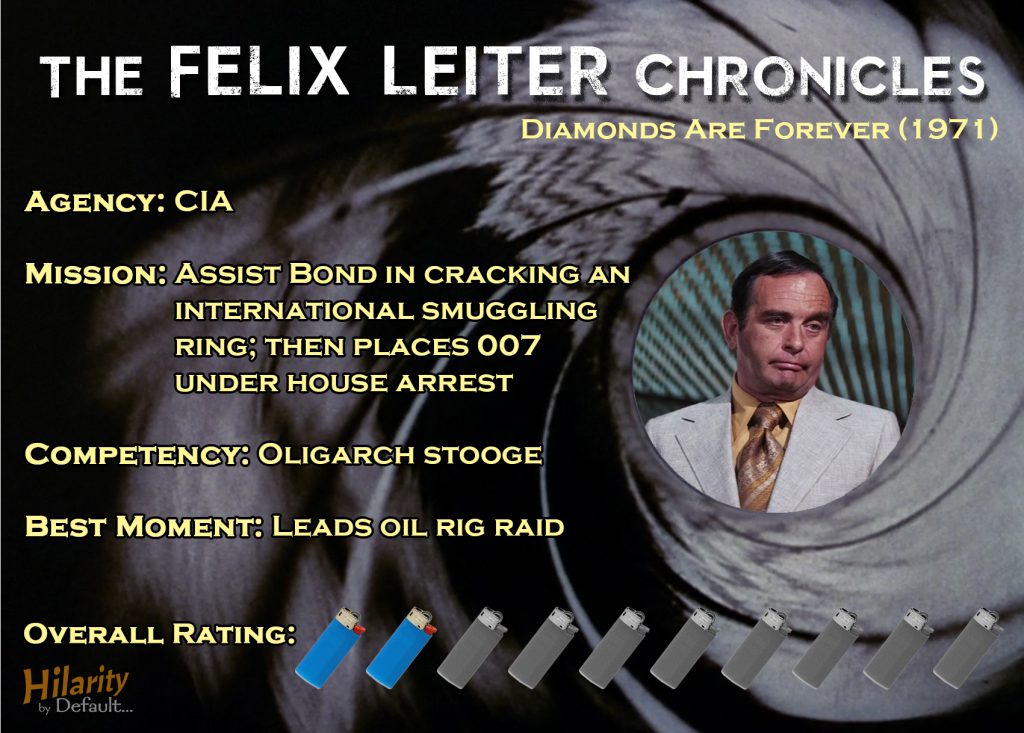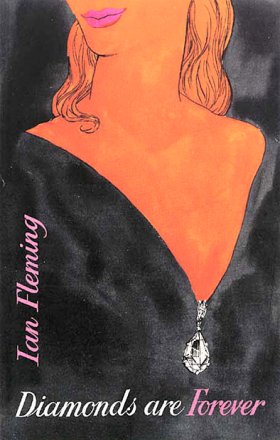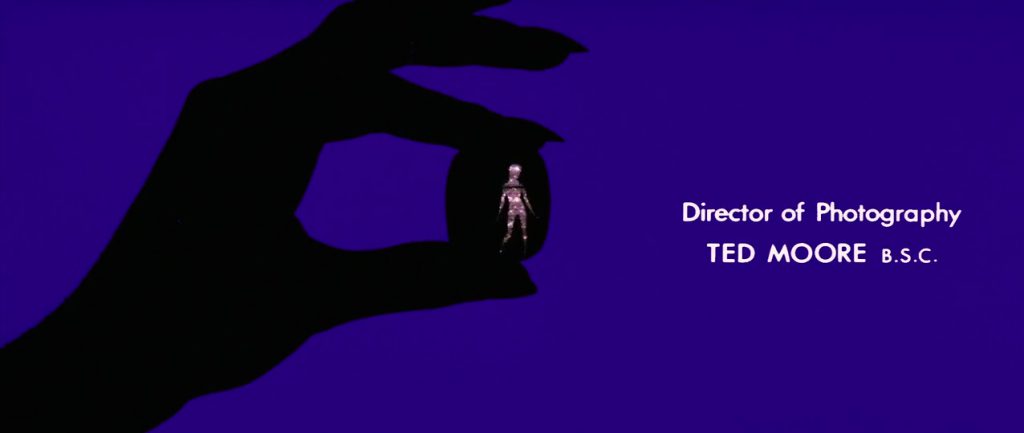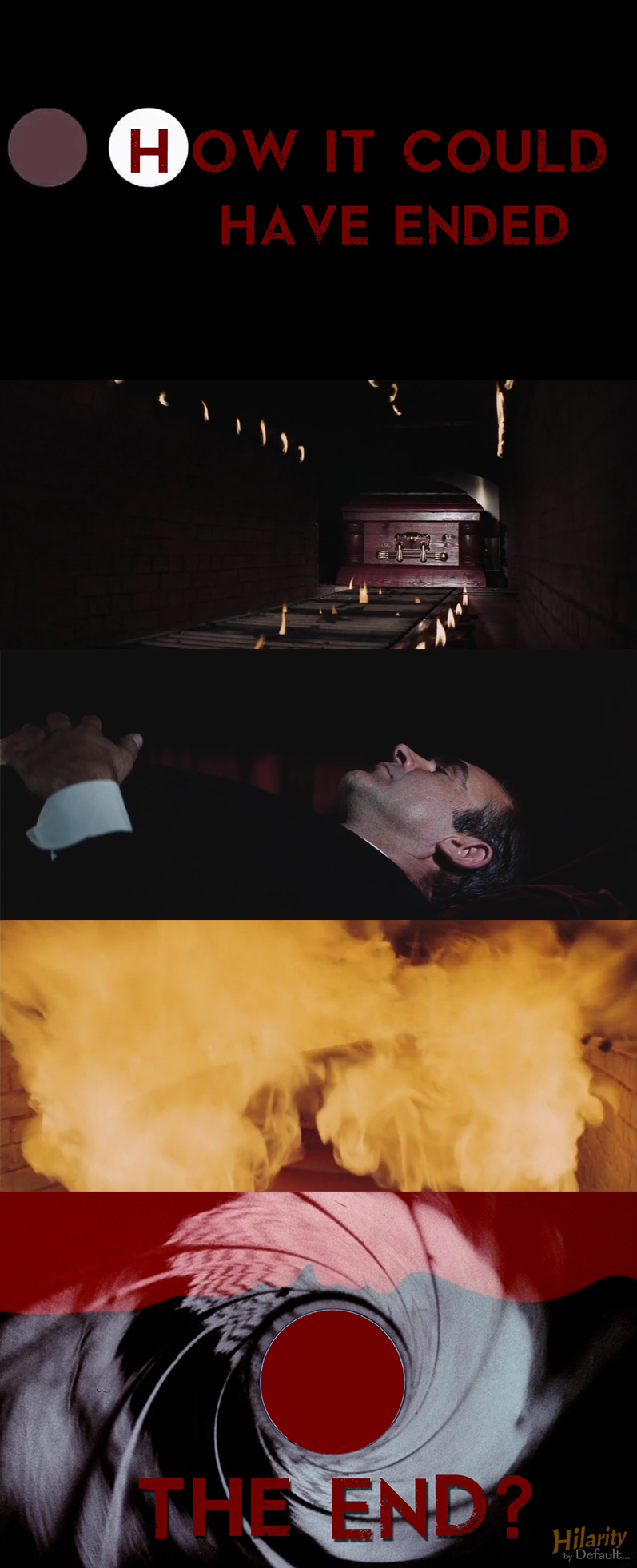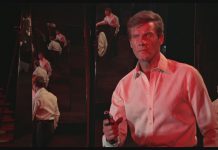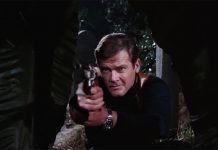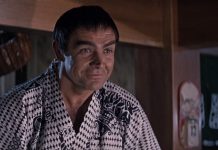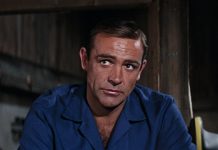Every Bond actor with more than three films under his belt has a low point (oddly, it is often their final outing as the character). With that said, it’s a much harder pill to swallow when the low point of arguably the most iconic 007 actor, Sean Connery, also happens to be one of, if not the worst films in the entire franchise to date. That is the story of the almost ironically titled Diamonds Are Forever – diamonds that may have best been left in the rough!
Diamonds Are Forever (1971) |
Diamonds Are Forever heralds the return of On Her Majesty’s Secret Service‘s proclaimed “other fella,” Connery, as he is hot on the trail of evil S.P.E.C.T.R.E. head, Ernst Stavro Blofeld (Charles Gray). For a few moments, the film actually seems to suggest that it will serve as a proper follow-up to the tragic events that concluded the previous film as Connery is practically ruthless in his pursuit (even going so far as to rip the top off a lady sunbather before using it to threaten her with strangulation!).

Sadly, it all goes downhill as soon as he enters a strange plastic surgery laboratory for one of the silliest, most confounding sequences in the franchise so far. As Bond apparently “kills” his nemesis via, um, hot mud drowning (?), he utters, “Welcome to hell, Blofeld.” True words indeed, for the rest of Diamonds Are Forever is a campy, thoughtless trek through a netherworld of cartoonish excess. Many have often criticized the Roger Moore-led Bond films as the epitome of camp in the series, yet it all started here. Heck, with the exception of Moonraker and the odd scene here or there in the early Moore era, Diamonds may be the campiest Bond film as a whole. Honestly, that’s a harsh knock on Moonraker; despite its downfalls, it was a competent, well-shot movie with some impressive sets to behold.
After Bond is chastised for being on holiday (guess mourning for your recently murdered wife is nothing but an inconvenience to British intelligence), he is assigned with a mission to uncover an elaborate, international diamond smuggling ring. Posing as a smuggler, he partners in crime with Tiffany Case (Jill St. John) as they connive of a method to get her latest stash to its destination in Las Vegas. Along the way, Bond finds himself: on a runaway moon buggy after crashing an Apollo hoax set in the Nevada desert…
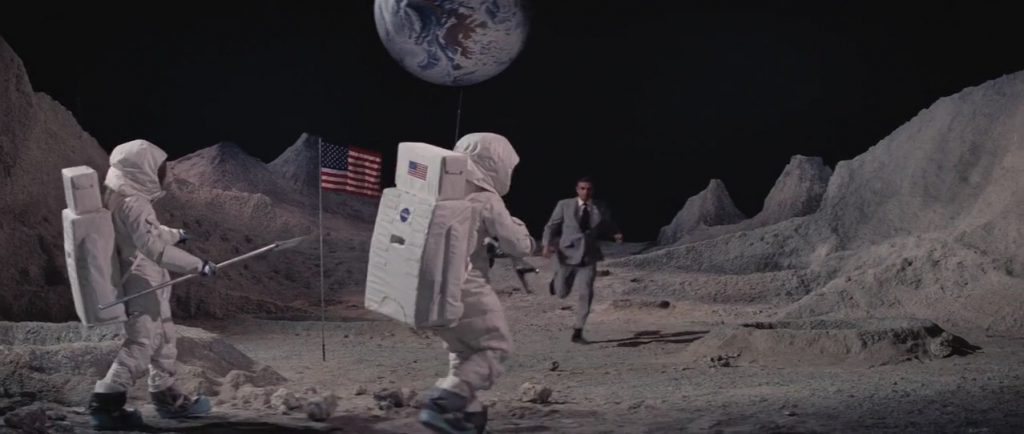
…dealing with eccentric, Howard Hughes-esque Willard Whyte (sausage king Jimmy Dean); in a desperate battle with two gymnasts named Bambi and Thumper; avoiding an oenology-challenged gay couple and their exploding desserts; and, on a race to stop a giant diamond-powered space laser headed by none other than Blofeld who is aided by his array of body double decoys (each, amusingly, with their own lackey white kitties). If that all seems as stupid as it does to me as I type this, these examples are merely scratches on the surface – and I haven’t even mentioned the slot machine playing elephant yet!
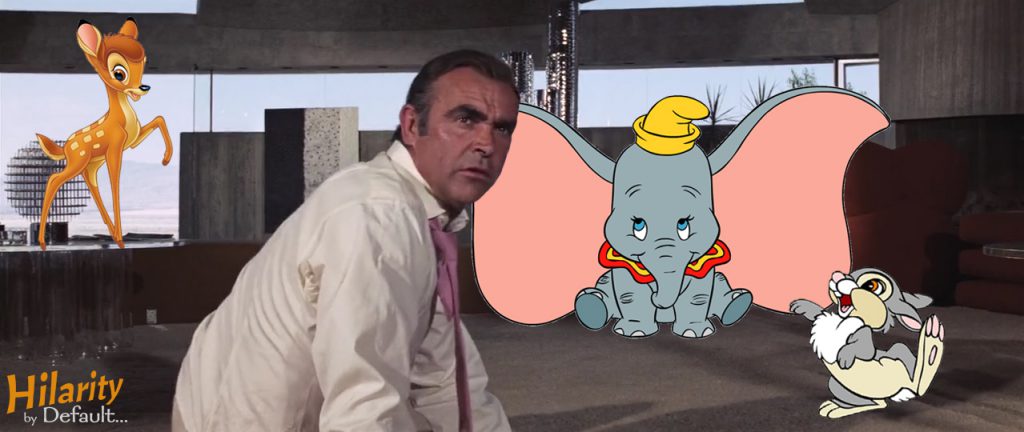
The movie feels as filthy as its Las Vegas band of incompetent criminal gangsters. There’s little danger or delight to be found here besides a few minor gems (for lack of a better word). In fact, it is probably easier to list out the lone positives in the film as any comprehensive attempt to list Diamonds Are Forever’s failures would take, well, forever:
- First and foremost, the film’s title tune, sung by Goldfinger’s Shirley Bassey, may very well be the best song in the franchise. Where “Goldfinger” was magnetically bombastic, “Diamonds Are Forever” is as smoothly enrapturing as its subject, featuring an arresting melody and a sparkling wit.
- Connery’s elevator fight with smuggler assassin Peter Franks (Joe Robinson) is a claustrophobic, well-choreographed battle. It may not reach the heights of From Russia with Love‘s Orient Express duel or, for that matter, many of George Lazenby‘s grapples, but it is an exciting sequence and proves to be one of the very few times in the film where it feels like Bond is in any true peril.
- Despite the many that fall flat, the film has some of the wittiest barbs out of any Bond film. Highlights include Bond’s first meeting with Tiffany where she practically models her multicolored wig and lingerie collection. Bemused at her latest combination, Bond states in approval, “That’s quite a nice little nothing you’re almost wearing.” Plus, who could forget the film’s most famous exchange:
Plenty (Lana Wood): “Hi, I’m Plenty.”
Bond (glancing at her revealing top): “But of course you are.”
Plenty: “Plenty O’Toole.”
Bond: “Named after your father, perhaps?”

- A brilliantly staged Mustang chase in a packed parking lot as Bond maneuvers in and out of empty spaces expertly avoiding all the police cars in pursuit. While the rest of the chase through the city streets of Las Vegas may run long with already cliche police pile ups, this tiny section is utter gold.
- Bond’s terrific, acrophobia-inducing scaling of the Las Vegas International Hotel (now the Las Vegas Hilton) which was the largest hotel in the world at the time. The scene is capped off by the only effective encounter Bond has with his nemesis as he faces off with two Blofelds and only one chance to kill the real one.
Beyond its early implications (none that are direct), Diamonds Are Forever serves more as a follow-up to You Only Live Twice than On Her Majesty’s Secret Service, even going as far as having its immediate opener set in Japan (with Live Twice-esque music to boot). Abashedly, considering that Majesty ended with Bond’s new bride dying in his arms, the film makes a few bizarre engagement jokes at Bond’s expense such as Moneypenny asking for a diamond ring upon his return home. Instead of Bond calling her a merciless git, he settles for bringing back some tulips instead (she was lucky he didn’t suggest lilies). Hell, the film even ends with a proposal gag!
Despite doing well at the box-office, Connery’s return marked Majesty as the true anomaly in the series despite the salient consequences it had on the character (it would take another two films before any direct reference would be made beyond insinuations). Instead of serving as a proper conclusion to the S.P.E.C.T.R.E. storyline, Diamonds Are Forever opts to try and recapture the magic of Goldfinger to a discernible fault. For instance:
- Both films focus on a precious rarity.
- Both open with Bond infiltrating a base in disguise and killing a villain in a bath.
- Shirley Bassey sings both film’s title tunes (she would return again once more for Moonraker).
- Both share much of the same production team and are helmed by director Guy Hamilton.
- M (Bernard Lee) takes Bond out to dine with an expert in the opening scenes.
- Moneypenny flirts on the topic of engagement rings.
- Both films feature a no-nonsense, nefarious female lead that succumbs to Bond’s charm.
- A minor villainous old lady is included.
- Sean Connery comically mutters the word “pussy.”
- The stories both start in Europe and end in America.
- A deadly laser is crucial to the plots.
- Bond is captured at the villain’s lair while Felix Leiter is part of a U.S. attacking squadron.
- Both feature homoerotic antagonists (Pussy Galore initially and Mr. Wint and Mr. Kidd).
- The villains show off their plans with an elaborate floor model at their residence.
- The villains are also both poised as respected, wealthy business conglomerates.
- Both films end with an after-climax coda with the remaining evildoers.
In fact, Diamonds Are Forever wasn’t originally scripted as a S.P.E.C.T.R.E. film at all; unsurprisingly, it was first drafted as a Goldfinger sequel with the hopes of luring back Gert Fröbe as Goldfinger’s diamond-loving twin seeking revenge. This approach was changed after producer Albert R. Broccoli had a dream where his reclusive friend, Howard Hughes, was usurped by an impostor. A great idea to be sure, but it ends up being a supplemental, overtly hair-brained twist for the likes of the already powerful Ernst Blofeld.
Of course, the real drive of Diamonds Are Forever is the return of Sean Connery who demanded the extra-ordinate fee of £1.25 million (which he genially used to establish the Scottish International Education Trust). Although he displays a little more flair than his tired turn in You Only Live Twice, his four year absence left him out-of-shape and saddled with his least convincing wig in the series and the unforgivable offense of a salmon hued tie (all his tuxedos should be ashamed of the association). While Bond is well-known as maintaining a suave, cool-under-pressure exterior, Connery’s take here puts him on the same stratosphere as an impenetrable comic book superhero. He may constantly get knocked out and captured, but he saunters on with the sense of a man who’s casually picking up his dry cleaning, robbing the film of any semblance of danger. Blofeld’s base is about to explode in a hurricane of hellfire? No worries, Bond has time for an Olympic precise swan dive.
Tiffany Case, despite a promising start, becomes more and more of a joke as the film wears on. By the end, even Bond calls her a “stupid twit” to her face! While I usually adamantly defend against the common assertion that all Bond girls are nothing more than disposable eye candy, there is almost nothing assert here. Her best quality? She is exceedingly qualified at striking magazine-cover worthy poses!
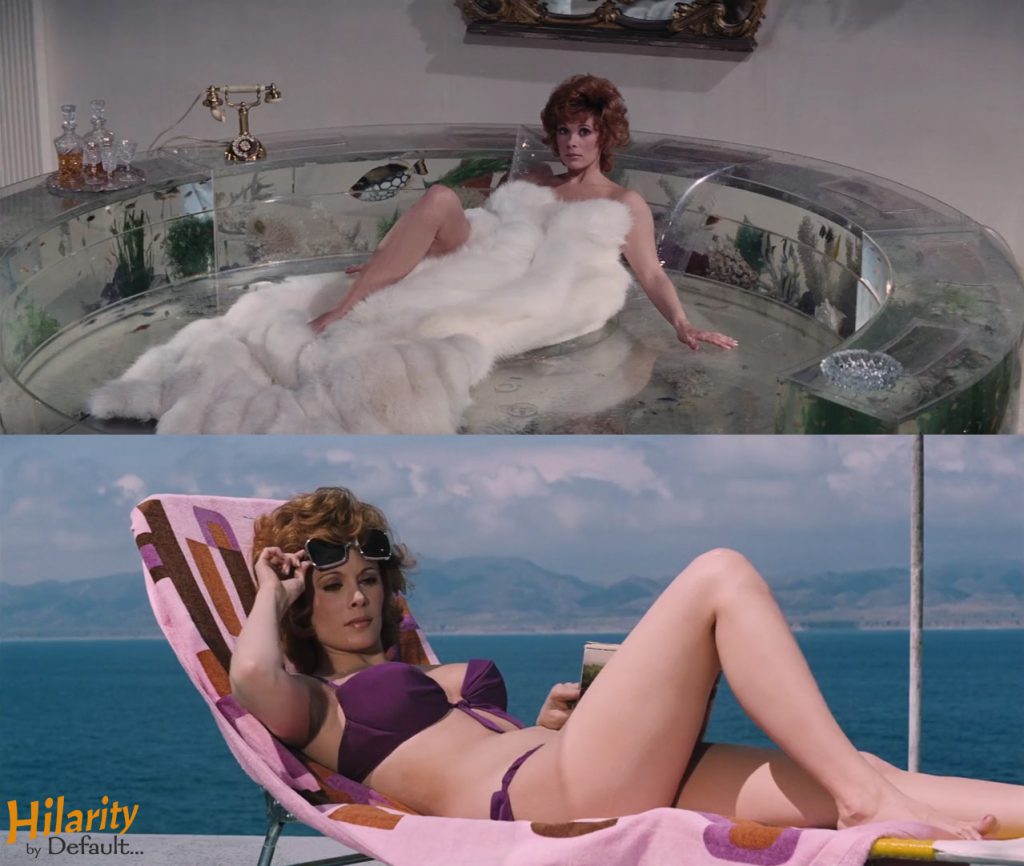
Although Tiffany converts into said stupid twit as the film progresses, Charles Gray’s Blofeld debuts as one. This isn’t Telly Savalas‘ imposing figure that haunted Bond throughout Majesty or the quiet, disfigured menace of Donald Pleasence in Live Twice. This is a mockery of the character that would seem more at ease in a dreaded Austin Powers spoof than a conventional threat for a 007 picture. His presence here is as impotent as it is incompetent, as he, despite multiple picture’s worth of dealing with Bond, repeatedly attempts to have him killed in the most ludicrous, easily escapable ways imaginable. Forget the ingenuity of MacGyver to devise a creative out – Pollyanna would suffice here (and she fell out of a tree).
Sure, it can be forgiven to a degree if a villain doesn’t straight up shoot Bond in the head, but any degree of suspension of belief is thrown out the window in this film. How so? Let’s take a look at two of Blofeld’s “devious” plans to excise himself of British heroics. 1.) He has Wint (Bruce Glover) and Kidd (Putter Smith) place an unconscious, unharmed Bond in a pipe in the Nevada desert where he is somehow overlooked by the pipe workers the next day and sealed underground (gees, I know that there is an attack on U.S. government regulations lately but this is the apotheosis of ineptitude). Of course, once Bond wakes up (and there’s somehow light in a cramped sealed off tunnel), he literally takes a ride out and makes a crack about rat-walking. 2.) In perhaps the most egregious example, at the films’s climax, Blofeld has Bond put in a prison with a convenient unlocked escape hatch and a handy rope lying next to it! How gracious of him! Does Blofeld have a deep, carnal impetus to consistently get dominated by Bond? That would be the most solid explanation for his perpetual idiocy in this film.
If that wasn’t bad enough, the film features the single, pivotal nexus that marks Blofeld as a throwaway jackass that the character wouldn’t recover from for four decades (save a one-note cameo in For Your Eyes Only). For those that wished that Charles Gray had gotten into the cross-dressing frivolity of The Rocky Horror Picture Show (for which he served as narrator), here’s your fluky chance!
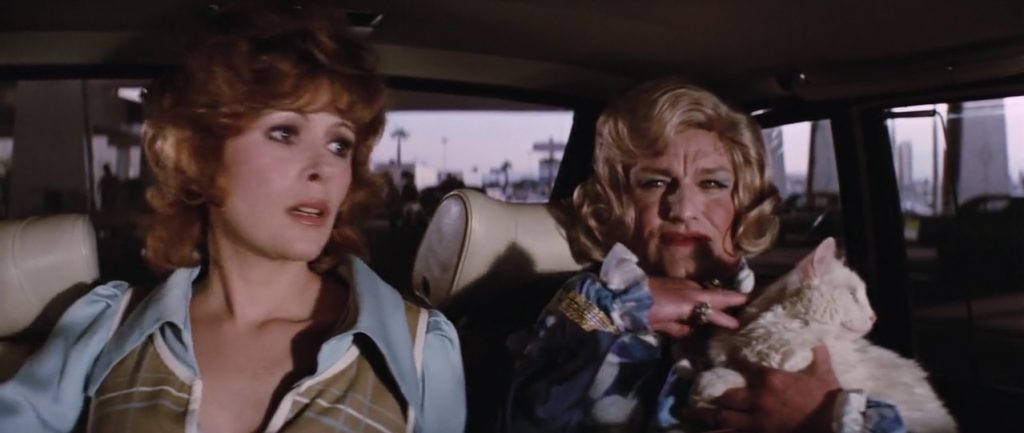
Felix Leiter (Norman Burton) returns after a two-film hiatus and is almost as useless here as he was in Thunderball. Though he plays a slightly more active role in the plot (again, akin to his turn in Goldfinger), he is far more obtuse and antagonistic towards his supposed best friend from across the pond – so much so that it’s hard to believe that there is indeed a connection between the two characters. He is as unfocused as inept, losing his tail on Tiffany and even placing Bond under house arrest after receiving orders from corporate tycoon Willard Whyte (nice to see the CIA blatantly working for the oligarchy). His only redeeming value? He does lead the attack squadron at the end. Guess that’s something.
Outside of the elevator fight and moments in the Las Vegas car chase, the action set pieces of Diamonds Are Forever are unusually average at best, routine and forgettable at worst. This film marks the the beginning of a short, tedious Bond trend that showcased long, scoreless vehicular chases where 007 ambles on while his pursuers ludicrously screw themselves over (save for one final opponent that Bond has to actually expel a smidgen of effort to take down). Case in point: the preposterous moon buggy chase where Bond, having seized control of the space vehicle from the aforesaid hoax, Area 51-style set, rides the moronic vehicle slowly through the desert. Though the buggy clearly loses a wheel (clearly an unintended goof), it clears a path to an easy, boring victory. Not even Wile E. Coyote and the Road Runner could make this scene more exciting.

Other action beats are flat-out embarrassing such as Bond’s tussle with the two deadly gymnast bodyguards nicknamed Bambi and Thumper and an after climax coda with the lackluster gay duo of Wint and Kidd. By the time Bond arrives at Blofeld’s oil rig lair via an inflatable attack beach ball, I had completely given up.

Ian Fleming’s Diamonds Are Forever |
It may come as no surprise that the film adaptation of Diamonds Are Forever has little in common with its source novel given its crazy production history; however, they do share quite a few corresponding traits. In actuality, the novel serves as a more faithful inspiration to the movie’s plot than You Only Live Twice – the only other major film deviation up to this point.
The basic set up is very similar – albeit without the S.P.E.C.T.R.E. association. Bond goes undercover as Peter Franks to infiltrate a diamond smuggling ring led by the dreaded Spangled Mob. He falls in love with Tiffany Case who, unlike the film, doesn’t suffer from a decline in basic intellect and even rescues a captured Bond held up in a ghost town called, oddly enough, Spectreville. Wint and Kidd are served best in transition from book to film, from their homosexual relationship to their demise aboard a cruise ship, including their fascination with scorpions. Besides a few other minor similarities such as the utilization of a dentist to smuggle diamonds out of Africa and the location of Las Vegas, the novel and film deviate significantly at the halfway point to make way for the movie’s space laser dalliances.
Fleming’s novel, his fourth in the series, is very much a vision of James Bond in the Western genre, from the desert ghost towns to a runaway train fight. While the gangsters come across as cliche as expected from similar works of the time period, it is undoubtedly more absorbing than anything presented in the film. What works against it is the extravagance of the film series – how do you follow up a hollowed-out volcano base and world terror with a small detective story where the climax involves an explosion and Bond simply shooting down a helicopter? [CURRENT BOND FILM SPOILER ALERT] Oh wait, that’s how SPECTRE (2015) ended, didn’t it (oddly, the big major return of Blofeld after his appearance in this film!)? [END OF SPOILER ALERT]
Diamonds and Mud Baths |
As aforementioned, one of the few lone gems in Diamonds Are Forever is the title tune along with John Barry‘s accompanying score which is one of his strongest efforts for the series. Maurice Binder’s title sequence, however, leaves a little to be desired despite being the natural progression from his approach in You Only Live Twice – cross-cutting geometric shapes and all. It is a far more seamless product that introduces motifs that would dominate the rest of his run in the franchise, setting a style that would become the standard. Extra points for the glistening gunbarrel.
Like many of the credit sequences from the first two decades of the series, the attempts to mask the nudity don’t come across quite as effective in today’s Blu-ray era (giving them an extra dose of titillation – especially for a PG-rated film). While I attest that this is quite harmless, it is interesting to note that the sixties to mid-eighties Bond films were less concerned with puritanism by presenting more adult content in their films such as the rear nudity in From Russia with Love, Ruby’s exposed nipple in Majesty, and Lana Wood’s see-through panties in this film. What may be surprising to some was that this wasn’t solely limited to female nudity as The Living Daylights (1987) would also include some eye-candy for the opposite sex.
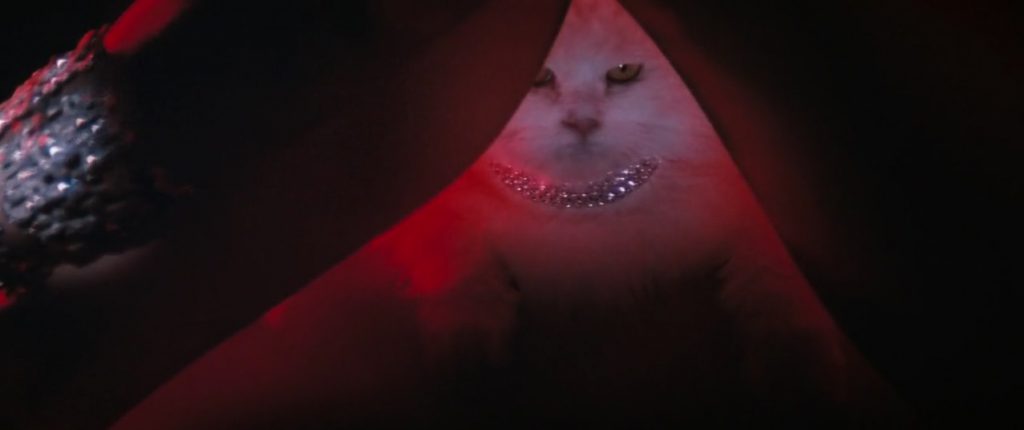
The pre-credits opener, which also includes some toplessness from the aforementioned unfortunate sunbather, is a complete failure notwithstanding the fact that it may be one of the most violent sequences in the film (besides a climbing pylon being gratuitously shot in someone’s forehead later in the film). It’s odd, tonally distorted, and the mud baths are as slimy and excremental as the rest of the film.
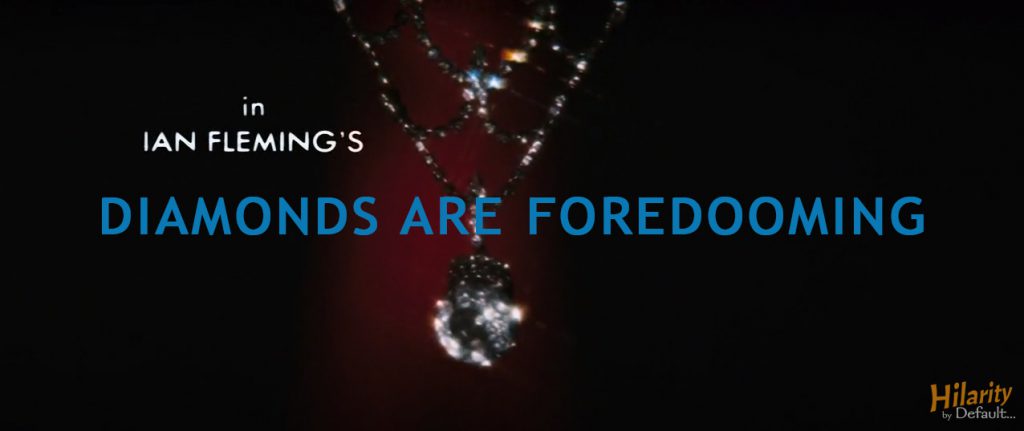
Final Thoughts |
Diamonds Are Forever is a mess. Perhaps partly due to an overconfidence in Connery’s return, the film feels like a case of all ideas getting approved – good or bad (Broccoli’s Howard Hughes dream providing a good example). While the attempt to ape Goldfinger is an understandable one given the series’ exponentially falling returns, the film fails on practically every level, birthing an end-product that feels as grimy as it does cheap.
As Connery’s second swan-song attempt, it would’ve stood as the poorest exit for the man most associated as the iconic spy. In a strange twist, despite having pledged never to return to the role, Connery would get another chance to bow out more properly. After all, you know what they say about saying “never.”
Random Afterthoughts… |
After Bond kills Peter Franks, he switches passports to preserve his ruse. Tiffany, upon examing Frank’s supposed passport is astonished. “You’ve just killed James Bond!” she yells. How the hell does a small time smuggler know the identity of a top secret British assassin? Is Bond truly that bad at his job?
As an added detriment to the shoddy opener, as Bond is strangling one poor miscreant, he asks him the location of Blofeld to which the henchman responds, “Cairo!” Quite a feat since his mouth never moves. Either a case of bad ADR or this villain just so happens to be a ventriloquist master!
Does Blofeld somehow look familiar, as if the actor has been in the series before? Indeed he has, but not as Blofeld. Charles Gray appeared in You Only Live Twice as Bond’s short-lived Japanese contact Henderson where he infamously gave 007 a martini, stirred not shaken. Guess incompetence is a running trait with this guy.

Plenty O’Toole has quite an extraordinary send-off. After Bond finds her drowned in Tiffany’s pool, he surmises that she was mistaken for Case after she tried to find her. Extraordinary because the two characters not only never meet in the film but have absolutely no connection to each other whatsoever (let alone Plenty knowing where Case lived). Chalk that up to a ridiculous deleted scene. Who cares about plot holes when we need to fill up screentime with elephants gambling at casinos!
This is the first of three successive Bond films to feature a grating, idiot American cop! Guess director Guy Hamilton had a strange fondness for this trope. It has been said that his mattress was stuffed full of copies of Smokey and the Bandit.
As Bond and Tiffany make love atop an aquarium water bed (guess that’s a thing), Bond becomes fixated with the fish swimming by and wears a familiar expression on his face – that of Peter Sellers in Casino Royale (1967).

James Bond will Return
in
Live and Let Die (1973)
Join 007 on the 7th of next month! For more, click here.














